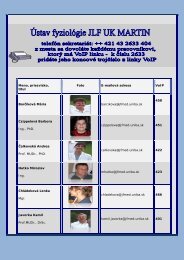Create successful ePaper yourself
Turn your PDF publications into a flip-book with our unique Google optimized e-Paper software.
<strong>MAKETA</strong> 7-2 <strong>po</strong> 8.1.2008 7:10 Str. 19<br />
A C T A M E D I C A M A R T I N I A N A 2 0 0 7 7/2 19<br />
tis key for atopy patch test reading (Figure 2) [5]. Reactions were classified as <strong>po</strong>sitive if there<br />
was erythema together with infiltration or papules. Erythema without palpable infiltration was<br />
considered as questionable, finally negative reaction. In both countries, all tests were done by the<br />
same two well-trained operators.<br />
Skin prick tests (SPT)<br />
SPT with two different concentrations of histamine were done in the left forearm: histamine<br />
10 mg/mL on the inner side 3 cm distally from the angular bend of the elbow and histamine<br />
1 mg/mL on the outer side 4 cm distally from the elbow bend. SPTs were done in a predefined area<br />
on the volar side of the left forearm, with a space of at least 2.5 cm between each prick. According<br />
to the International Study of Asthma and Allergic Diseases in Childhood (ISAAC) protocol<br />
phase 2 the following inhalant allergens panel were tested: Dermatophagoides pteronyssinus, Dermatophagoides<br />
farinae, cat dander, Alternaria tenuis, mixed grasses 1 (Avena sativa, Hordeum<br />
vulgare, Secale cereale, Triticum sativum), mixed grasses 2 (Dactylis glomerata, Festuca pratensis,<br />
Lolium perenne, Phleum pratense, Poa pratensis), and mixed trees (Betula verrucosa, Corylus<br />
avellana, Alnus glutinosa) (ALK-ABELLO, Hørsholm, Denmark). On the right volar forearm we<br />
pricked the same four fresh food allergens used for APT (cow milk, hen egg, tomato and wheat<br />
flour dissolved in 1 mg/10 ml saline). Negative controls, 50% glycerine in saline, were pricked on<br />
the left forearm. In both countries, we used the same type of histamine, allergens, negative control<br />
and 1-mm tip metallic lancets (ALK-ABELLO, Hørsholm, Denmark). The lancet was pricked<br />
vertically into the skin through each drop for 2 s with firm pressure, starting with histamine 10<br />
mg/mL. A new lancet was used for each prick test. Ten minutes after the procedure ended, the<br />
wheals were outlined with a thin felt-tip pen. The contours were transferred to the record sheet<br />
with translucent tape. The size of each wheal was measured as the mean of the longest diameter<br />
and the diameter perpendicular to it at its mid <strong>po</strong>int. A <strong>po</strong>sitive skin prick test was defined<br />
as a wheal ≥ 3 mm in its longest dimension. In both countries, all tests were done by the same<br />
two well-trained operators.<br />
Serum studies<br />
Peripheral venous blood samples were taken from all children. Eosinophils were measured<br />
within 2 hours by an automated blood cell counter (Advia 120, Bayer ® , Leverkusen, Germany;<br />
Digicel 1200, Abbot ® ).<br />
Statistical methods<br />
All data are expressed as means ± SD. Data were analysed by the software program SPSS version<br />
9.0 (SPSS Inc. Chicago, IL, USA). Student’s two-tailed t test, chi square (χ 2 ) test and Fisher’s<br />
exact test were used for statistical comparison. P values less than or equal to 0.05 were considered<br />
to indicate statistical significance.<br />
RESULTS<br />
Table 1 shows that studied children, when subdivided according to the nationality, present<br />
higher histamine skin reactivity, prevalence of <strong>po</strong>sitive skin prick tests for food or for<br />
inhalants in Italian children whereas eosinophil cell count is higher in Slovakian children.<br />
Positive skin tests (especially multiple or more intense <strong>po</strong>sitivity) and eosinophil cell count<br />
were found to be significantly higher in males while histamine skin reactivity did not differ<br />
between sexes.<br />
Table 2 shows that atopy patch tests for foods were each <strong>po</strong>sitive in 5-15 % of the tested subjects<br />
with about 21 % having at least one <strong>po</strong>sitive APT result: in general, they were more frequently<br />
<strong>po</strong>sitive in Italian children, especially so for what cow milk and tomato were concerned.<br />
Also some differences in the prevalence of <strong>po</strong>sitive APT have been found between males and<br />
females: there was a general tendency for APT to be strongly <strong>po</strong>sitive (many papules) more frequently<br />
in males significantly so for hen egg (p = 0.002) and in the number of children for at least

















